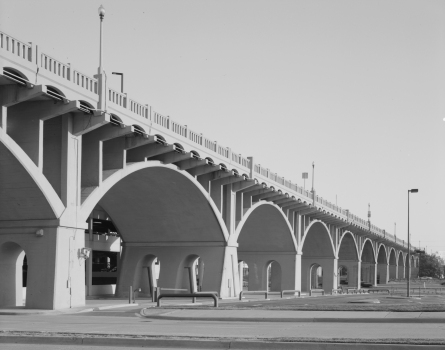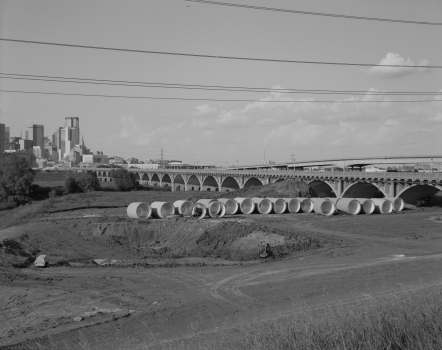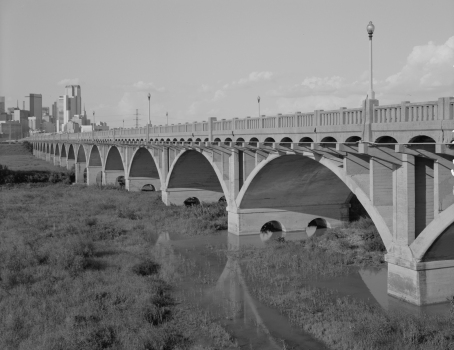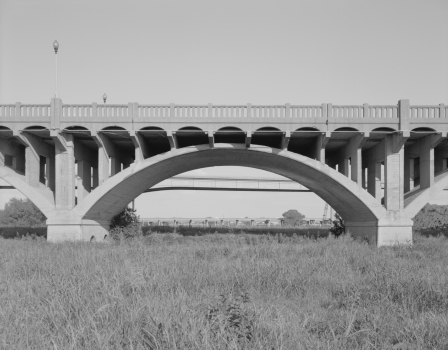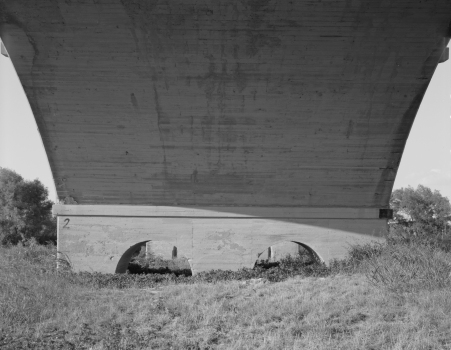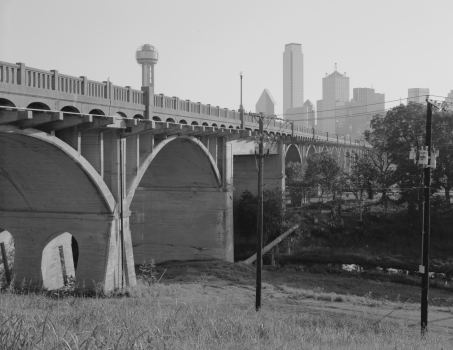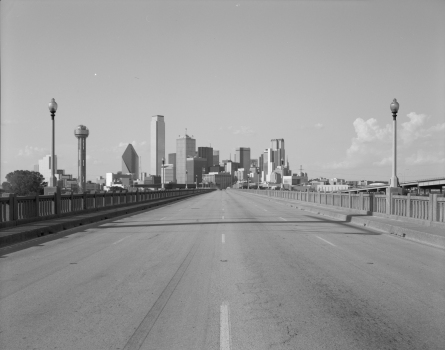General Information
Project Type
| Structure: |
Deck arch bridge |
|---|---|
| Function / usage: |
Road bridge |
| Material: |
Reinforced concrete bridge Structurae Plus/Pro - Subscribe Now! |
Location
| Location: |
Dallas, Dallas County, Texas, USA |
|---|---|
| Address: | South Houston Street |
| Crosses: |
|
| Coordinates: | 32° 45' 54.96" N 96° 48' 45.19" W |
Technical Information
Dimensions
| main span | 31.39 m | |
| total length | 1 458.56 m | |
| deck width | 10.09 m |
Materials
| deck |
reinforced concrete
|
|---|---|
| piers |
reinforced concrete
|
| arches |
reinforced concrete
|
| abutments |
reinforced concrete
|
| piers on arch |
reinforced concrete
|
Report of the Historic American Engineering Record
| Location: | Spanning Trinity River at Houston Street, Dallas, Dallas County, Texas. UTM: 14/705200/3627560 USGS: Dallas, Texas, quadrangle. |
|---|---|
| Date of Construction: | 1910-1912 |
| Designer: | Ira G. Hedrick, Hedrick and Cochrane, consulting engineers, Kansas City, Missouri; M. R. Ash, associate engineer. |
| Builder: | Corrigan, Lee, and Halpin, Kansas City, Missouri, general contractor; Gulf Concrete Construction Company, Houston, Texas, foundation sub-contractor. |
| Present Owner: | City of Dallas. |
| Present Use: | Vehicular bridge. |
| Significance: | At the time of its construction, the Dallas-Oak Cliff Viaduct at Houston Street was the longest reinforced concrete highway viaduct in the world, and it was the first high-level, all-weather crossing of the Trinity River at Dallas. The Houston Street Viaduct was nominated to the National Register ofHistoric Places in 1984. |
| Historian: | Robert W. Jackson, August 1996 |
| Project Information: | This document was prepared as part of the Texas Historic Bridges Recording Project performed during the summer of 1996 by the Historic American Engineering Record (HAER). The project was sponsored by the Texas Department of Transportation (TxDOT). |
Introduction: Site Development to 1908
The February 1912 completion of the approximately 5,106'-long Dallas-Oak Cliff Viaduct, now known as the Houston Street Viaduct, marked an important victory by Dallas in its long struggle with the Trinity River, a normally shallow and sluggish stream subject to periodic flooding of disastrous extent. Many bridges were constructed across the river prior to 1912, but these structures were either destroyed or rendered temporarily useless whenever the Trinity overran its banks. Eventually, the community solved the problems caused by Trinity River flooding in two ways: first was the construction of flood-proof viaducts, with the Dallas-Oak Cliff Viaduct being the only such structure until 1930; and second was the construction of a levee system during the early years of the Great Depression. But prior to 1912, area residents frequently found the river impassable, and always hard to predict.
The first bridge across the Trinity River at Dallas was a toll bridge built in 1855 at the foot of Commerce Street by an early Dallas entrepreneur named Alexander Cockrell. Constructed at the site of the first Dallas ferry terminus, this approximately 520'-long covered wood bridge was washed out by a flood in 1858. It wasn't until 1872 that Cockrell's widow, Sarah, succeeded in erecting a new bridge composed of two wrought-iron bowstring arches which were ordered by mail from the Moseley Iron Company of St. Louis.2 This structure was replaced about 1889 by two steel Pratt through trusses purchased from the Missouri Valley Bridge and Iron Works ofLevenworth, Kansas.
This new bridge replaced the iron bridge as the main public road bridge to Oak Cliff, the suburb located on the opposite side of the river from Dallas which was annexed in 1903. A long wood bridge was also constructed near Cadiz Street, and the Zang Boulevard Turnpike, an earthen fill bridge with a single steel span across the river channel, was erected just north of the present Houston Street Viaduct. The Cadiz Street Bridge, the Zang Boulevard Turnpike, and the western approaches of the Commerce Street Bridge were all washed away or inundated by the flood of 1908, leaving the residents of Oak Cliff once again temporarily dependent on ferry service.3
Design and Construction, 1908-1912
In response to the flood, plans were made for a permanent all-weather viaduct located at Houston Street that would stretch over the entire width of the Trinity floodplain. George Banneman Dealey, manager of The Dallas Morning News, was one of the leaders of this effort. Dealey had seen the Intercity Viaduct in Kansas City in August 1908 and envisioned a similar structure as the solution to his city's problems with the oft-flooded Trinity River. He launched a series of articles and photographs to win public support for a viaduct, a project that was also actively supported by Oak Cliff promoters Charles A. Mangold and J. F. Zang. After considerable effort by these men and others, a $609,797 bond issue was eventually passed by Dallas County voters. However, the campaign for this viaduct engendered a considerable amount of bitterness and controversy, similar in nature to the debate which would later attend the 1930-34 construction of Trinity River levee district improvements.
Some commentators asserted that the tax burden created by the Houston Street Viaduct project would become such an onerous burden on the community that "Dallas County wouldn't be fit to live in." As one chronicler of the effort has said, "the magnitude of it seemed to stun many residents ofDallas. They couldn't understand money that ran into such figures, and charges of graft were freely made and hotly denied."
Despite strong opposition, construction began on the Dallas-Oak Cliff Viaduct in October 1910 and the bridge was officially opened February 1912. Scheduled for Washington's Birthday, the dedication ceremony attracted a crowd said to number in the "tens of thousands" and was largely paid for by Mangold. Zang was named Grand Marshall and Texas Governor Oscar Colquitt delivered the dedication. After a choirs of children from Oak Cliff and Dallas sang "America," the head of the pigeon committee said: "My dear bird, I liberate you to carry throughout Texas to your home a message of love and greeting, bearing on your wings the word that the great viaduct is completed. . . ." Then the birds were kissed on the head my sixteen maids of honor and released to the sky. Each bird had a tube on its leg containing the message, "Liberated at the Dallas-Oak Cliff Viaduct."
Probably of greater impact in terms of announcing the wonders of the bridge to the world were the series of postcards sold throughout the state by Dallas companies such as Frey Post Card and News Company and C Weichsel Company that proclaimed the bridge as "The longest concrete structure of its kind in the world," or "Reinforced Concrete Viaduct over Trinity River between Oak Cliff and Dallas, Texas. Longest in the World." These cards claimed the length of the structure to be 5,840'-0", the cost to be "nearly $700,000," and the deck to be "71 feet above low water."
Another card made by Curt Teich and Company of Chicago that was widely sold in the 1930s depicted the viaduct and Dallas skyline by night. This card featured the illuminations of the concrete lamp posts, which made the bridge appear, as described by The WPA Dallas Guide and History, as "a beaded ribbon of light."
In fact, the figures provided by the post cards must have been rough approximations because the length ofthe bridge was only about 5,106 feet. Ifthe length of an additional earthen approach of about 787 feet is added, the total bridge length exceeds that claimed by the cards. The eventual cost ofthe viaduct, not counting the cost ofthe earthen approach, was approximately $675,000. This figure was far more than the approximately $563,000 that remained for bridge construction after the cost ofright-of-way acquisition and construction ofthe Oak Cliff Approach was subtracted from the bond issue.
Description
Whatever the precise final figures may have been, the bridge was certainly a lengthy and costly structure. Beginning at the Dallas end, the bridge is composed of an approximately 439'-0" reinforced concrete trestle; twenty-seven reinforced concrete arches of 71'-6" span; a 98'-0" concrete-covered steel plate girder section over the river channel; twenty-four reinforced concrete arches of 71'-6" span; and an approximately 181'-long reinforced concrete trestle.
The abutment piers on the Dallas side were carried to bedrock, but the other piers and the Oak Cliff abutment were founded on piles. All of the piers are pierced longitudinally by two openings 9'-0" wide at the top by arches. The distance from the springing line to the top of these openings is 4'-0"; the reinforcing bars are placed just above them.
The arches are curved slabs measuring 79'-6" center to center of piers with a rise of 17'-0", varying in thickness from about 16" at the crown to about 36" at the springs. The arches support a deck with a total width of 56'-0", and the roadway is constructed in such a way that a railroad track could be laid.
The steel girder group consists of four steel girders of 98'-0" between supports, which carry in direct compression the horizontal thrust of the adjacent arch spans. The thrust is carried into the bottom flanges of the girders by means of special cast-iron shoes. The upright portion of the shoe bears against the concrete of the pile on one side and against a cast-steel wedge on the other, the wedge being driven between the cast-steel shoe and the end of the bottom flange angles. Steel girders were used instead of steel reinforced concrete girders due to the necessity of providing sufficient clearance for vessels passing under the bridge while also keeping the grade of the viaduct as low as possible. It was believed at the time the bridge was constructed that the Trinity could some day be made navigable, and so the U.S. War Department, having jurisdiction over navigable waterways, required a 90'-0" horizontal clearance and a 60'-0" vertical clearance throughout the entire 90*-0" width.
History of Structure and Site, 1912 to Present
The viaduct has changed very little since it was first opened for public use. When the Trinity River channel was straightened as part of the levee improvement project of the early 1930s, about $100,000 was spent to strengthen the side walls and rails. A concrete handrail was added at about this time. In 1944 another $30,000 was spent to strengthened the piers of the new channel, which were weakened by the levee improvement project and by a flood in 1942. In 1946, a resurfacing cost Dallas County another $13,500.
Early in 1973 the Jefferson Street Viaduct was completed just downstream of the Houston Street Viaduct, and the opening of this bridge allowed traffic flow on the Houston Street Viaduct to be changed from two-way to one-way. No changes were made to the bridge at this time, but six years later it was necessary to make extensive repairs to the railing and roadway.
When a five-story parking garage for Reunion Arena was built between the Houston and Jefferson Street Viaducts in 1980, stairways were added to the bridge. In 1984, more repair work was conducted, and a construction contract of approximately one million dollars for rehabilitation of the section between Young Street and Hotel Street was completed in January 1993.
Given the age and heavy use of the bridge, it is still in relatively good condition. It is certain, however, that extensive and costly repairs will need to be made throughout its remaining life in order for this magnificent and historically significant artifact from the past to remain a safe and useful part of Dallas' transportation infrastructure.
Sources Consulted
Cochran, John H. Dallas County: A Record of its Pioneers and Progress. Dallas: Service Publishing Company, 1928.
Dillon, David. "A Bridge Linking Dallas With its Past." Dallas Morning News, 3 April 1986.
Greene, A. C. Dallas: The Deciding Years — A Historical Portrait. Austin: Encino Press, 1973.
Holmes, Maxine, and Gerald D. Saxon, ed. The WPA Dallas Guide and History. Denton, Texas: University of North Texas Press, 1992.
Landrum, Lynn W. Dallas and the Trinity. Dallas: A. H. Belo Corp., 1933.
McDonald, William L. Dallas Rediscovered: A Photographic Chronicle of Urban Expansion, 1870-1925.
Dallas: Dallas Historical Society, 1978. Minutaglio, Bill and Holly Williams. The Hidden City: Oak Cliff, Texas. Dallas: Elmwood Press, 1990.
"Reinforced-Concrete Viaduct Between Dallas and Oak Cliff, Texas," Engineering News 65, No. 13 (30 March 1911): 392-95.
Rogers, John William. The Lusty Texans of Dallas. Dallas: E. P. Dutton and Co., 1960.
Sharpe, Ernest. G. B. Dealey of the Dallas News. New York: Henry Holt and Co., 1955.
Wallis, Gene. "The Trinity's Swan Song Spree of 1908." Dallas Morning News, 18 March 1931.
Participants
Currently there is no information available about persons or companies having participated in this project.
Relevant Web Sites
- About this
data sheet - Structure-ID
20005575 - Published on:
27/09/2002 - Last updated on:
31/05/2017

